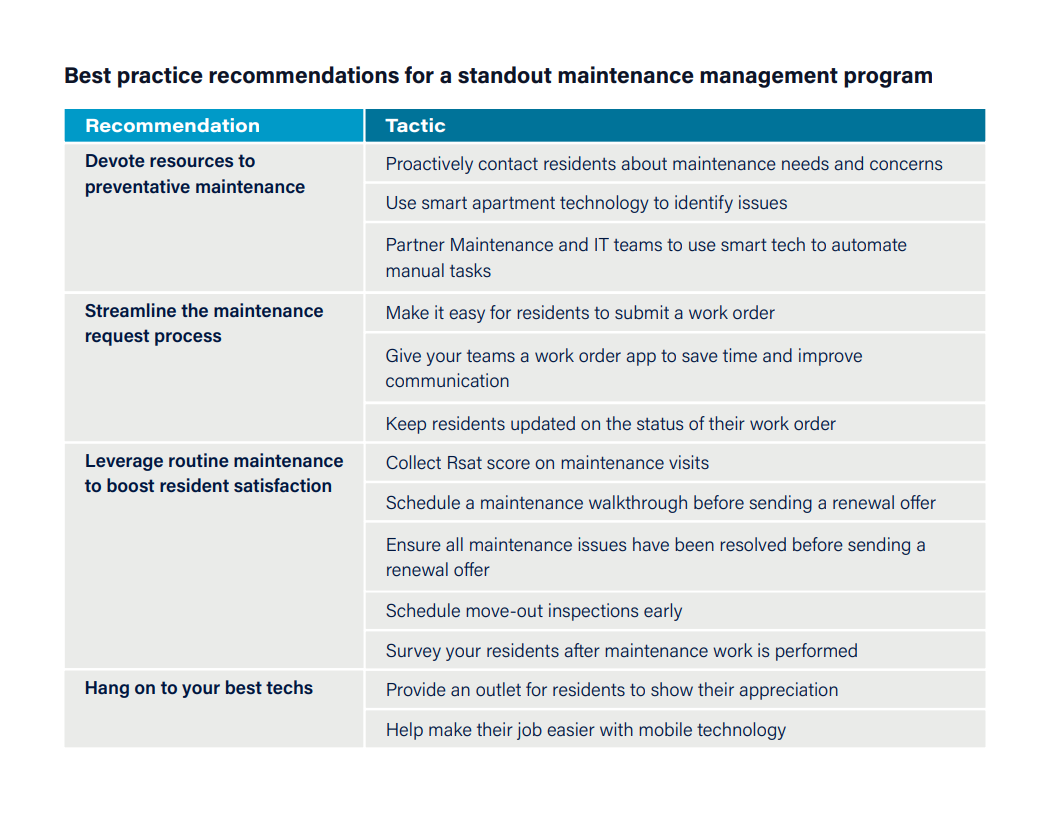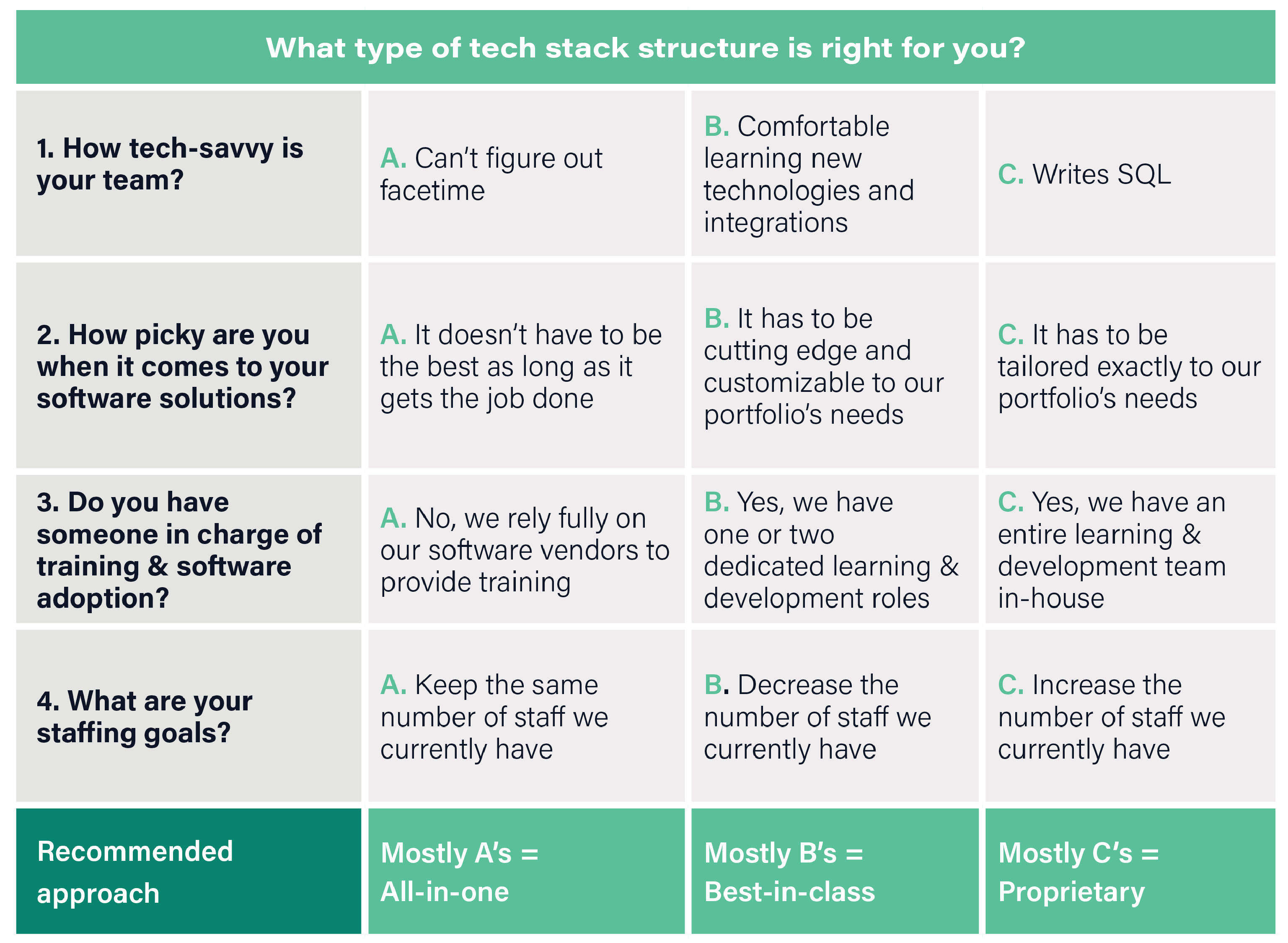How to structure your apartment rental software stack
Your apartment rental software stack can be assembled with proprietary technology, all-in-one platforms, or best-in-class solutions, so find out the pros and cons of each approach.
Searching for apartment rental software might seem overwhelming. After all, there are so many factors to consider.
To help guide your decision, you’ll want to understand the distinct features of each type of software. Sometimes though, you don’t discover the drawbacks of each one until you’ve used it. Luckily, industry leaders who have used them all told us about some of the ins and outs many people might not consider up front.
Before we hear their stories, let’s dive into the three kinds of apartment rental solutions that are used in multifamily.
The top three ways to build an apartment rental software stack
Structuring your stack to fit the needs of your portfolio is the first step to putting all the right technology in place. Most property management companies choose one of three methods:
- Proprietary: Custom built apartment rental software
- All-in-one: A single platform with multiple applications
- Best-in-class: Specialized apartment rental software solutions that integrate with each other
So, what is the best way to determine which approach is right for your portfolio? Let’s examine the pros and cons of each method, and the types of portfolios they typically suit.


FREE DOWNLOAD
Get the guide to building a best-in-class tech stack
Download this guide to discover the benefits of a comprehensive tech stack for property staff and residents and how to boost staff efficiency and resident satisfaction with a tech stack built specifically for your portfolio.
1. Proprietary software for property management
Sometimes property management companies can’t find the level of customization they need from an apartment rental software. So they might decide to hire a team to build their own proprietary enterprise software. Typically, only goliath companies tend to have the time, resources, and ambition to go this route.
| Pros | Cons |
|---|---|
| Customization: You can create a truly customized system perfectly tailored to your portfolio. | Expertise requirements: You will need a team of coders with an extensive background in property technology. |
| Scalability: If you already have a large portfolio and are looking to add more properties quickly, custom software could help you scale effectively. | Expenses: Along with a talented team of engineers, you will need a colossal budget to build a custom software solution from scratch. |
| Competitive advantages: Depending on the solution, custom software could provide a competitive advantage relative to your competitors. | Maintenance: Because technology is ever-evolving, you could get left behind if you don’t have engineers constantly upgrading your software. |
| No dedicated support: You and your residents won’t have a dedicated support team. So if something fails, it will take your time, energy, and resources to field resident complaints and fix the issues that arise. |
2. All-in-one property management software for multifamily
Essentially a Swiss Army knife for property managers, all-in-one’s squeeze several tools into a single offering. However, most of them have limited capabilities compared to specialty apartment rental software designed for a particular service. Common applications include: accounting, investing, marketing, leasing, and resident tools. This lets apartment operators manage their entire portfolio using a platform.
These single solutions tend to be popular amongst smaller property management companies. That’s usually because they may not have the resources to vet and manage multiple technology vendors.
| Pros | Cons |
|---|---|
| Consolidation: The idea of a single platform being able to solve multiple challenges at once can be appealing to those with limited internal resources. | Limited functionality: With many all-in-one solutions, each product in the suite lacks in-depth functionality needed to do a particular job well. |
| Simplicity: If your team is not particularly tech-savvy, only having to learn one platform could help avoid confusion and shorten the learning curve. Additionally, having a single login to manage multiple applications means less passwords to keep track of. | Not customizable: Since all-in-one solutions tend to be more rigid in their functionality, they come with little to no options for customization. |
| Efficiency: You’ll only have one vendor to make payments to and one support number to call when problems arise. | Additional expenses: You’ll likely have access to tools you don’t need or want, which in most cases makes all-in-one providers more expensive. |
| Weaker integrations: You may find that components of an all-in-one solution don’t integrate as seamlessly as you’d expect. This is because all-in-one providers often fill gaps in their product offerings by acquiring companies and rebranding those products as their own. | |
| Support: Adding new products through acquisition also affects the support you receive. Support teams for all-in-one platforms won’t have as much in-depth knowledge about each specific part of their offering. Which could end up costing you more time to resolve the issue. |
3. Best-in-class multifamily software solutions
A best-in-class structure allows management companies to use the absolute best solution for components of their tech stack. Companies opt for this method because the features offered by best-in-class providers are often more extensive than other types of apartment rental solutions.
They can also be tailored to the client’s needs. While assembling a best-in-class technology stack means dealing with several providers, it also means upgrades are much easier, and the company has a unique system that is a leader in its industry.
| Pros | Cons |
|---|---|
| Specialization: Best-in-class solutions offer power-packed systems that address a specific issue. | Multiple vendors: Having multiple solutions means you have more vendor relationships to manage. |
| Customization: Best-in-class providers are typically willing to customize their product based on the needs of their clients. Additionally, rather than being tied to the cost of a unified solution, you can pick and choose solutions that fit within your budget. | Multiple credentials: Multiple applications means you will also have multiple login credentials to keep track of. |
| Maintenance: Upgrades are easier and more frequent because specialized companies stay on top of evolving technologies and industry trends. | Varying integrations: If you choose vendors who do not have strong partnerships with one another, you may run into some integration issues. |
| Flexibility: The best-in-class method prevents companies from “putting all their eggs into one basket.” If you ever want to break away from a unified solution, it can be a painful transition, and that’s something most all-in-one providers count on. | Defined requirements: Best-in-class solutions are not one-size-fits-all, so you will need to have a good idea about the specific features you are looking for. |
| Implementation: Specialized vendors usually deliver a shorter implementation time, particularly if you are using a web-based solution. |
Experts weigh in on software for apartment management
Finding what apartment rental software is right for you can be challenging. The first consideration should be the resources you have at hand. If you have an expansive portfolio that is experiencing rapid growth, as well as a specialized team of coders, time to spare, and a hefty budget, then a completely customized, proprietary system may be right for you.
On the other hand, if you have a smaller portfolio with limited internal resources and a not-so-tech-savvy team, an all-in-one platform could help avoid confusion and give you the standard tools you need to run your business.
Shelli Smith, Director of Business Services at Harbor Group, has advice for mom-and-pop property management companies. “Consider having a one-stop-shop type of an experience. It might not be best-of-class, but it may have what’s needed for the ease of employee onboarding, client support and to provide the customer experience you’re looking for.”
But buyer beware. All-in-one solutions don’t always live up to the hype.
“Some folks make the mistake of thinking that if they use a single vendor, everything will be streamlined and simplified,” warns Stephen Baker, Chief Product Officer at Zego. “But the benefits of all-in-one tech stacks tend to get overstated. There are plenty of pros to a single solution with multiple functionalities. But not every piece of the solution works as well as it’s advertised.”
Most midsize to large property management companies agree that the best tech stacks are well-rounded, open, and interconnected. Property management companies can stay competitive by picking and choosing top-notch solutions that allow for customization. This lets them avoid building something in-house. If you fall into this category and have the right resources at your disposal, then a best-in-class approach is ideal.
What apartment rental software solution is right for you?
Take our quiz below to determine which type of tech stack is best for your portfolio. Answer each question and keep track of whether you selected mostly A’s, B’s, or C’s. If you answer mostly A’s, our recommended approach for your business is an all-in-one provider. If you answer mostly B’s, we recommend a best-in-class approach. And if you answer mostly C’s, our recommended approach is to build your own proprietary apartment rental software.

Still unsure how to structure your tech stack? Download The Ultimate Guide to building a “Best-in-class” PropTech stack to learn what type of tech stack structure is best for your portfolio, and what software and digital tools comprise a “best-in-class” PropTech stack.
Implement an apartment rental software stack at your communities
Book a demo with Zego and see how an apartment rental software stack can amplify your efficiency, result in time savings, and elevate your property management experience within your communities.